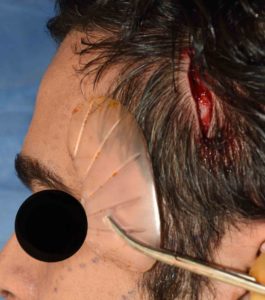Temporal augmentation is most commonly done by injection techniques using synthetic fillers or fat. While offering a non-surgical approach, their results are often not permanent and the temporal contour may be uneven or asymmetric. More recently developed temporal implants offer an assured volume and a smooth temporal contour result. Placed through a small incision inside the temporal hairline, they are inserted and positioned in the subfascial plane on top of the temporalis muscle.
While the temporal area is not dimensionally complex, it does have two distinct aesthetic zones which are important to distinguish before surgery. In mild to moderate cases of temporal hollowing, the indentation is seen lower right next to the side of the lateral orbital rim and down to the zygomatic arch. This is known as a Zone 1 temporal deficiency, the most common seen, and is treated by a standard temporal implant. When the temporal hollowing is more severe the deficiency will go all the way up the temporal line at the side of the forehead. This upper aesthetic temporal area is known as Zone 2. Some patients refer to Zone 2 as the ‘side of the forehead’ although anatomically it is the upper temporal zone. Its augmentation requires an extended temporal implant that covers both Zones 1 and 2.

It is of critical importance to preoperatively determine the patient’s temporal augmentation needs by zone to avoid having an inadequate temporal augmentation by using the wrong implant style.
Dr. Barry Eppley
Indianapolis, Indiana


